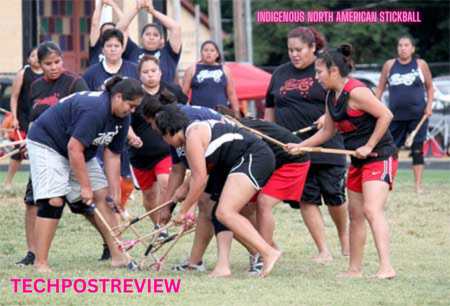The vast and diverse cultural tapestry of North America is woven with countless threads of traditions, rituals, and sports. Among these myriad cultural expressions, the game of Indigenous North American stickball stands out as one of the most ancient and significant. A precursor to modern lacrosse, stickball has played a pivotal role in the social and spiritual lives of indigenous tribes for centuries. This article dives deep into the rich history, significance, and evolution of this time-honored game.
The Roots of Stickball
The origins of stickball trace back thousands of years, with evidence suggesting that native tribes of North America played this game long before European contact. Different tribes had their unique versions of the game, but common elements included using sticks to throw, catch, or strike a ball and targeting goals or posts to score points.
Historical records indicate that stickball was not merely a pastime. For many tribes, it had profound social, political, and spiritual implications. Games could resolve disputes, strengthen alliances, train young warriors, or even play a role in religious rituals.
Cultural and Spiritual Significance
Stickball was never just a game. For tribes like the Choctaw, Cherokee, and Creek, it held profound cultural and spiritual significance. Often referred to as the “little brother of war”, stickball was a way for tribes to resolve disputes without resorting to actual warfare. A single match could decide territorial disputes, settle personal vendettas, or even serve as a matchmaking event.
From a spiritual perspective, stickball was a conduit to the divine. Players often sought the guidance and protection of spiritual leaders or shamans before matches. Rituals, dances, and ceremonies would accompany the games, invoking the blessings of the ancestors and the natural world.
Rules and Gameplay
Stickball’s rules and gameplay varied across tribes. Generally, teams comprised of 20 to 100 players, though some matches reportedly had up to 1000 players on each side. The field could be anywhere from 100 yards to several miles long.
Players wielded sticks made of hickory or other hardwoods, intricately carved and adorned. The ball, usually made of hide or wood, had to be maneuvered towards the opposing side’s goalpost. Using hands was forbidden; players relied solely on their sticks.
Physical contact was a significant aspect of the game. Players would tackle, shove, and block opponents, making it a rigorous and sometimes dangerous sport.
Evolution and Modern Influence
With European contact and colonization, Indigenous North American stickball underwent significant changes. Colonizers viewed the sport with a mix of fascination and disapproval. Over time, they began adapting the game, leading to the birth of modern lacrosse.
While lacrosse gained popularity and spread across North America and Europe, traditional stickball remained an integral part of indigenous communities. Today, many tribes continue to play stickball, preserving its rich history and cultural significance.
Challenges and Revival
Like many aspects of indigenous culture, stickball faced challenges in the wake of colonization and forced assimilation. Government policies and boarding schools actively sought to suppress indigenous traditions, including sports like stickball.
However, in the face of adversity, indigenous communities have shown resilience. The latter half of the 20th century witnessed a revival of stickball. Tournaments, inter-tribal games, and cultural festivals have played a pivotal role in this resurgence, ensuring that the ancient sport continues to thrive in the modern age.
In Retrospect: The Legacy of Stickball
The enduring legacy of Indigenous North American stickball is a testament to the strength and resilience of indigenous cultures. From its ancient roots to its modern iterations, stickball remains a powerful symbol of unity, tradition, and cultural pride.
In a world that often forgets the value of ancient traditions, stickball serves as a reminder of the rich tapestry of cultures that have shaped North America. It’s a game, a ritual, a tradition, and most importantly, a link to the past that guides the future.
Final Thoughts
Indigenous North American stickball, with its deep-rooted history and cultural significance, offers a unique window into the soul of North America’s first inhabitants. As we appreciate and participate in modern sports, let’s not forget the ancient games that paved the way and continue to hold profound meaning for many. Stickball is not just a sport; it’s a journey through time, a dance of spirits, and a celebration of indigenous resilience and pride.

